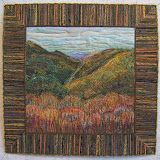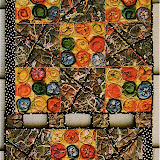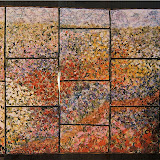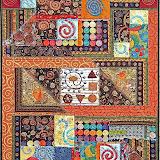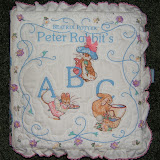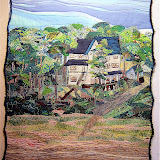Four More Violet Pieces
added to my wild flower series ...
All these had begun as a single whole piece. It was the size of the one donated to the charity auction that I wrote about in my last blog post. At the end of two full days work, I did NOT like it at all! I went to bed with the thought of closing up my studio for good ... thinking maybe I had "lost it" and should consider going back to making functional quilts. For me the designing process to make those is less complex and frustrating to get satisfactory results.
But the next day I had a different thought ... cut it up! It's the woods in the distance that I fell in love with at the beginning of this series. It's the part I liked best in the first one. Particularly at the beginning of building that piece.
beginning of Violets #1
So ... it was cut in half. I allowed a bit of foreground space for patches of flowers. Pieces were cut from the right and left sides for the sake of the composition, I worked on the woods a bit more, added the violets to the foreground, and then bordered it with a frame made from the piece that had been cut from the center of the frame for Violets #1. Three green skeleton leaves were added for balance in the bottom section of the frame. Here's the result ...
Wild Flower Series - Violets #2 (17"x 12.5")
The bottom section of that cut apart piece had a real birch bark piece. This was my main consideration for how to size the next picture in this series. The leaves had been sewn in place on the original so that was also given thought. I chose to use the perspective of "bending down close to see the violets" in this one. It's bordered with what had been cut away from the center of the frame for Violets #2.
Wild Flower Series - Violets #3 (13"x 8")
Well ... now I had the quilted center that had been cut away from the frame of the above piece. This prompted me to stitch together the two sections cut from the sides of the woods in #2 to create this vignette to fit within it. Just a bit more work and it became my favorite in this whole violet series.
Wild Flower Series - Violets #4 (5.5"x 8")
I was definitely back in the groove and happy to be in the studio by this time ... that being a few days later. The previous small piece made me fall in love with making art again. Composing this one from the last section of what had been "cut up" came easy. My perspective on this one is "I can almost smell those blossoms."
Wild Flower Series - Violets #5 (9"x 8")
These four pieces that were intended to be a single large one are destined to the gallery in Michigan, Good Goods, for their special 25th anniversary exhibition in mid-June. I've since made two more pieces for this occasion. I'll post about those next.
































































 Fabric Bird Sculpture Pattern
Fabric Bird Sculpture Pattern



